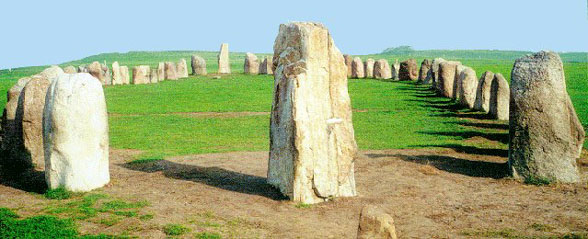The Ales Stenar mytology

There is no doubt that the most significant gods
in the sunship are the sungod Heimdall (guardian of the sanctuaries),
the fertility god Ing-Frö, the summergod Balder and the wintergod
Ull. The heavenly powers of these well-known nordic gods have since
ancient times been representative for the numbersymbolic placings of
the four opposing sunrocks 1 and 15 in the ship's combined solar year
calender and Zodiak (the Zodiak, the star constellations, where the
gods were believed to have their dwellings).
The sungod Heimdall's symbol rock is clearly marked by the 3,2 m father's rock in the northwest, and that is the time for the sundown during the summer solstice on the 22/6, when the sun symbolically enters the constellation of Cancer, where Heimdall was believed to have his heavenly dwelling. The sun symbol og the fertilitygod is marked with the opposing 2,4 m motherstone in the south east, which marks the time for the sunrise of the winter solstice on the 24/12, when the sunwheel turns and a new year begins in the solar year calender of Al. The sun enters the constellation of Capricorn, where the sungod Ing-Frö was thought to have his dwelling. The turn of the sunship is also marked by the sunset and sunrise in the center of the sunship(see pictures).
The enormous importance of the sungod Balder and the wintergod Ull is symbol- ized by the two opposing 15 sunrocks amidships, counted from southeast and northwest. The sun rises, at these sunrocks, at 3.42 AM on the 23/5 and sets at 15.42 PM on the 24/11, which for the star constellation watchers of ancient times marked that the sun had entered the constellations of Gemini and Sagittarius, which are the heavenly areas for the opposing dwellings of Balder and Ull.
According to greek mythology, the twins Castor and Pollux, one fair and one dark, lived in the constellation of Gemini. They also represented the sunrise and the sunset in the two heavenly spheres, i.e. the both halves of the Zodiak. The roman historian Tacitus indentifies in his book about the Teutons, which he wrote in the year 98 A.D., Castor and Pollux with an ancient nordic pair of gods by the name of Alcis. The name Alcis is identical with the germanic and gothic word Ahls, which means sanctuary, the place where the sungod Heim-dall ruled, according to the poem "Grimnismal". But Alcis, Als, as in the rocks of Als, can also be connected with the anglosaxon verb "ealzian" (elgian), which means protect. This meaning also corresponds to the indoeuropean (arian and ancient-teutonic) idea, that two protecting light-divinities, the two sons of the sungod Dyaus (the avcinians, "sons of the sun"), ruled over one half of the solar year each: the bright summer and the dark winter respectively.